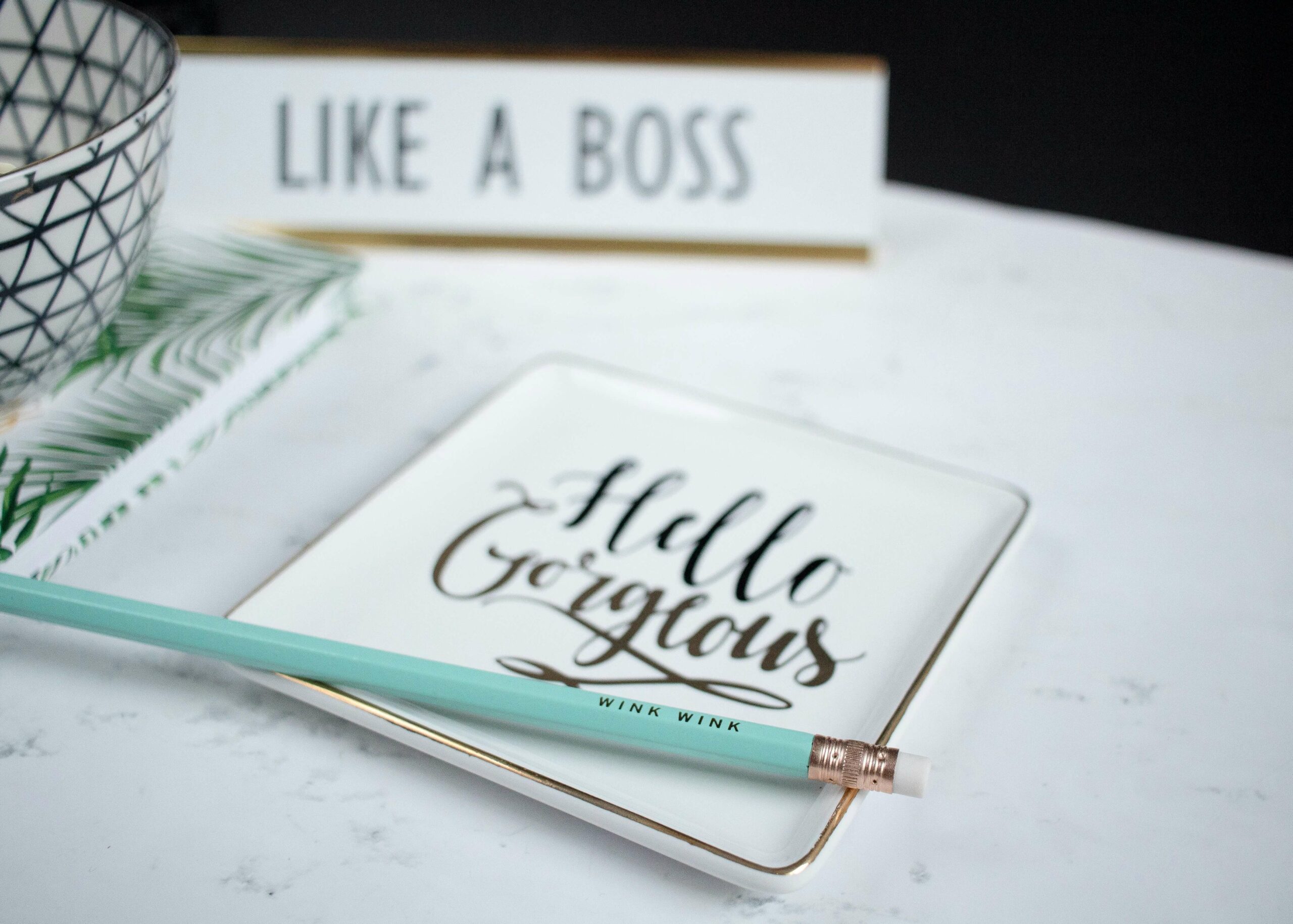When I quit my job in September 2011, I knew I needed a website.
I wasn’t sure how I’d make money as a freelancer, but I knew I had experience in marketing and writing.
So I chose the title “marketing communications consultant” and decided to learn from the market itself. (Click here to read more about how I got started.)
Before I was willing to put myself out there, however, I wanted a coherent presence online. So I threw myself headfirst into DIY WordPress. When I finally emerged, blinking and bruised, about 9,000 hours later, I felt…okay about it
I had a portfolio that showcased my experience, a tagline I liked (“making connections that count”), and a very generous graphic designer friend who helped me make a logo. I was officially ready to work.

My old logo!
Fast forward 3 years.
I need to update my services (and stop selling social media help). I decide to sharpen my focus on storytelling and ramp up my writing work. I’m deep in the copywriting world now, which means I spend WAY too much time fussing and trying to make my own site copy perfect.

My 2014 tagline.
After 47 attempts to align my digital platform with my vision, my new site was updated, though it barely reflected the grand vision I had in my mind. Even though I was dissatisfied, my brain was burnt out and I. was. over it.
On November 2014, I turned 30 years old. I wanted a bigger, bolder website to match my vision, but I knew one more DIY job would do me in. So I vowed to go pro in 2015.
3 weeks later, in the way of the Universe, I met a website developer at a local MeetUp group. Brandi Bernoskie (of Alchemy+Aim) totally blew my mind with her masterful blend of soul, strategy, and coding genius.
About a month after that, Brandi introduced me to her crazy-talented photographer, another local ladypreneur named Carrie Coleman. She wound up doing all of my photos, even my “stock photos,” even though she specializes in relationship photography!
I knew I’d write my own copy, so by February 2015, I’d gathered my tiny brand building team.
I was incredibly excited—and hilariously unprepared.
I thought I’d get my new site finished by April, tops. But it would be another TEN MONTHS before I was able whisper those three little words: “My site’s live.”
Now I realize I’d overlooked the obvious:
all good things take time.
Things like:
- Unwinding from the stress and change of your best year in business.
- Choosing a nail polish color that’s both unexpected and seasonally appropriate (I’m loving pine green right now).
- Defining the right message, graphics, design, copy, and products for a website that looks, feels, and sounds like you.
So don’t stress if you’ve been planning and/or working on a website upgrade for months (or years!).
Because your website is more than a bundle of code locked on invisible servers and bouncing from Earth to satellites and back.
It’s YOU, in digi-form.
And as long as you are reading this, you are a living, breathing organism, which means you’re constantly growing and changing.
Pinpointing the specific version of YOU that accurately represents your current hopes, dreams, and abilities, then translating it into words, images, and WordPress theme…that’s tough.
I beat myself up with miserable, unrealistic timetables for my website rebrand.
Please don’t do this to yourself!
Instead, get crystal clear on the 5 core items you need to pull off a major overhaul.
So BEFORE you get into the nitty gritty (copywriting, website design & development, personal styling and photography, etc.), you have a few cornerstone concepts in place.
I’ve pulled together my shortlist in the hopes it lessons your self-flagellation (if not your learning curve). Because a long, slow climb does NOT mean you’re doing it wrong.
5 Things You Must Know Before You Rebrand Your Website
- What products & services do you sell?
When I started to work on my current rebrand, I was in the midst of testing new products.
Unsurprisingly, it took time for me to test, refine, and get clear on my specific packages and products.
First, I had to determine which services people were willing to pay for.
Then I had to decide which services I actually WANTED to sell.
Determining THAT allowed me to write copy, which allowed me to give Brandi the content to build my site.
Chances are, you fit into 1 or 2 camps when it comes to products and services:
Camp 1: You spend WAY too much time stressing about logos, job titles, and the specific words on their blog bio…but you haven’t sold anything yet.
Let me just say it: until you know what you sell, nothing else matters. Until somebody pays you money, you don’t have a business.
You can spend MONTHS wrapping a present, hand-lettering the paper and gluing sequins in intricate patterns, but if you don’t have anything in the box itself, that present’s gonna be a letdown. Right?
So if you find yourself hemming and hawing about your services, unable to get started because you can’t decide what you’re selling, take my absolute best advice: pick one thing and test it. You can always add more later.
Camp 2: You spend WAY too much time testing, refining, and sculpting every detail of your new e-course…instead of putting it out there.
Hey there, fellow perfectionist. Remember that until you put your services out there, you’re robbing people of the chance to work with you. And the world needs what you’re selling. So pull the trigger already. (And trust me, you don’t need every video from every module in order to write a sales page.)
- What do your ideal clients care about?
If you’re a B-Schooler, you’ve heard Marie Forleo’s term “Ideal Client Avatar” (or ICA). If not, this is basically a brainstorming exercise to imagine your ideal client in great detail.
Her questions are excellent (and B-School is, too!). But here’s the thing: not every detail matters.
Why?
Because when you’re in the process of growing your business, writing website copy, and building your personal brand platform, you don’t need to know every little detail (shoes, hair color, name) of your ICA.
The ONLY thing you really need to know about your ICA? Is what she cares about.
What are her priorities in life? What frustrates her? What delights her? What makes her daydream and sweat and stress and celebrate?
You can get these answers in one of two ways:
- Market research; and
- Self-research.
Market research—getting information from others—is the best option, hands down. But if you know that you fit your target demographic, you can do self-research and ask yourself the questions, too.
My WHOLE BIZ LIFE CHANGED when I did extensive market research this past summer.
Seriously. It’s been a game-changer. I’d done market research before, but not like this. For the first time, I really GOT it…and truly, marketing myself has been a breeze ever since.
- What’s your style?
What images, colors, and general “vibe” do you want your personal brand to convey?
Some questions to think about:
- What makes you happy? (For me, that’s maps, books, and rainbows.)
- What hobbies and habits do you enjoy? (Exploring, reading, thinking about the big mysteries of life.)
- What do your friends say reminds them of you? (Everyone I know associates me with rainbows, sprinkles, and books. To the point that a friend who sells paper goods ordered this wrapping paper because it reminded her of me. Hilariously, my boyfriend bought a sheet at our local stationary store, wrapped by birthday present in it, and didn’t realize the connection until I pointed it out. I guess what I’m saying is, I’m really into sprinkles. Hence then glitter dust sprinkle effect of the )
- When you’re scrolling through Pinterest, what colors/textures/art works/photography make your jaw hit the floor? (For me, it was everything I put into this moon board.)

My brand mood board for my new website.
As you think about these questions, start curating answers in a Pinterest board. You’re welcome to check out my personal brand Pinterest board if you think it will inspire you.
While you’re clicking and adding all the beauty in the entire freaking world, make sure you add a few pics with specific shots or photos you like. This will help your eventual photographer get a feel for what you want.
You should also visit other websites for inspiration. Whether you hire a designer, a developer, or both, you want to be able to reference layouts, looks, and the feelings of websites you love. So Pin that ish or take a screenshot and save it somewhere handy.
SIGH. I could do this part forever.
- What’s your funnel?
This is simpler than it sounds. Before you get hung up on pay-per-click Facebook ad training or the anatomy of a perfect discovery call, you need to get clear on the overall structure of your sales funnel.
At a very basic level, a sales funnel is the step-by-step process one person will follow to be transformed from a stranger to a paying customer.
For most service-based entrepreneurs, a basic sales funnel looks like this:
- Internet stranger –>
- website visitor –>
- email subscriber –>
- discovery call –>
- service purchase
In this funnel, a website visitor qualifies herself as a prospect (a person who might need help at some point) when she signs up for your email list.
When she books a discovery call, she becomes a lead (someone who needs help right now).
Only when you’ve closed the sale (i.e. she agrees to work with you and pays) does she become a client.
When you’re rebranding your website, you want to make sure every call to action, design element, and tech widget supports your sales funnel. How are you going to drive visitors to take the next step on every single page?
For this reason, I suggest creating a copy funnel, too: one that outlines the flow of visitors within your website.
Here are some potential copy funnels:
- Internet stranger –> home page –> email opt-in
- Internet stranger –> home page –> services page –> book discovery call
- Internet stranger–> sales page –> buy now (if you’re advertising)
- Internet stranger –> home page –> about page –> services page –> contact page –> contact
If you map this customer flow upfront, you’ll have an easier time organizing your website pages.
Personally, I got hung up on differentiating two types of services (DIY vs. done-for-you). Which left me stuck and stalling for WEEKS on my website development.
But guess what? When I mapped out my actual visitor flow, I realized the division in services didn’t matter nearly as much as I thought. I arrived at an easy solution, then moved on with my life (hooray!).
- What’s your message?
I’ve been consulting, freelancing, and pivoting my writing and marketing services for over 4 years. I’ve done a lot of market research. I know what people are willing to pay for.
Really, I’ve had a vague idea of message for years. In fact, it’s been the same message for most of my life: Be true to yourself. Take pride in your voice and ideas. Go forth and have a grand time in this big brilliant lifetime you’ve been blessed with.
But in order to combine the two, to knit my big ideas into a value proposition that sells, I had to be willing to take a risk.
I had to place my bets on one idea, take a deep breath, and run with it.
Because you won’t FEEL clear on your message until you ACT like you’ve got mad clarity. You do the research, take your best guess, and go forth.
Commitment to one idea is scary. Especially when you’re a creative idea generator who doesn’t like saying no or shutting doors or burning bridges.
I had to evolve—emotionally, psychologically, and spiritually—before I was willing to risk the commitment required to feel truly clear on my message.
So if you’re struggling with brand message clarity, here’s my recommendation to you:
- Research your target market. Find out what they need.
- Play around with different ideas. Write down whatever pops into your head when you’re showering, walking the dog, etc.
- Choose your favorite idea and—here’s the key concept—live with it for a while. Test it out on Facebook friends. Try writing and speaking with this concept draped like a cape on your shoulders.
Only once you’ve lived in your message for a little while will you know if it actually fits.
This summer, I committed to a message, a line of thinking, a few research-based results. At first, I hated it. I thought for sure I was off-base, unqualified, mismatched, etc. etc.
But as days passed, I warmed up to my own idea. It’s kind of like when you get a new pair of glasses: at first they look super weird on your face, and you kind of hate your nose, and you’re sure you’ve made a tragic mistake that has ruined your chance to resuscitate your modeling career. But one day you catch a glimpse of yourself in a shop window and think, Hey, who’s that cutie pie?
Like a new pair of glasses, your brand message might feel like a scary commitment. But remember, you’re in control. You can change it at any time. Just give it a chance and you might discover, as I did, that everything you wanted lay on the far side of your fear.
Like always.
Oh, there is one last thing.
NO website gets written, developed, and launched without the business owner making one fundamental decision: I am ready.
So do yourself a favor and make that decision first. 🙂
Are you gearing up for YOUR brand new brand in 2016? Or have you rebranded recently?
Leave me a comment with your biggest ah-ha moment during this transformational process. I’d love to hear what lightbulbs went off for you!



